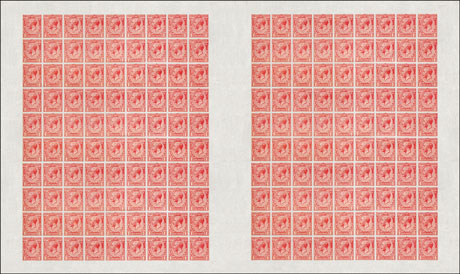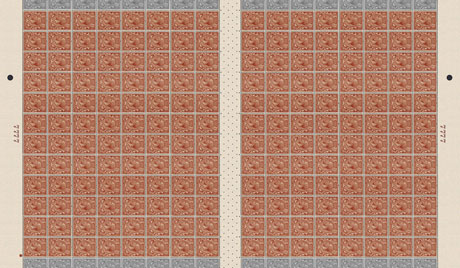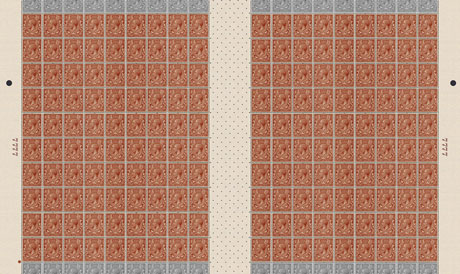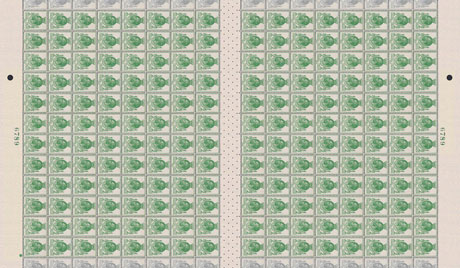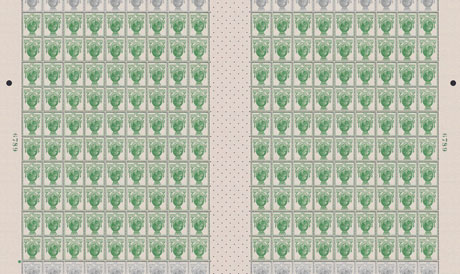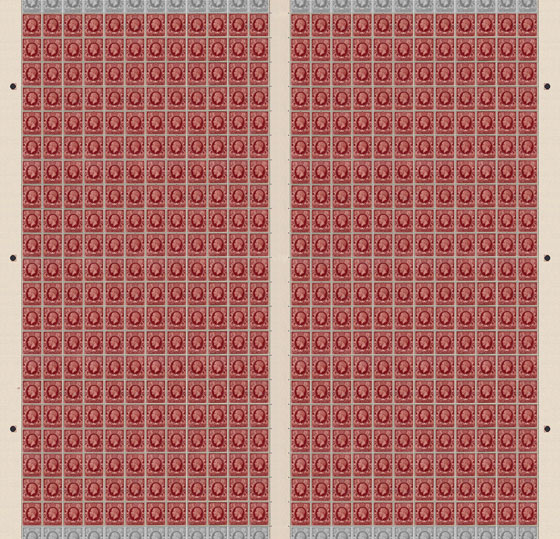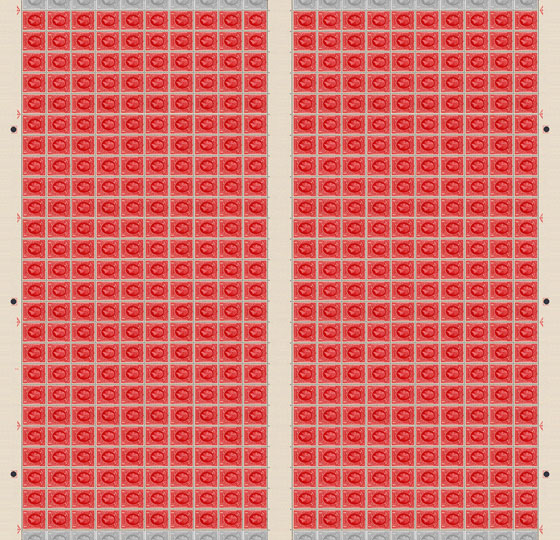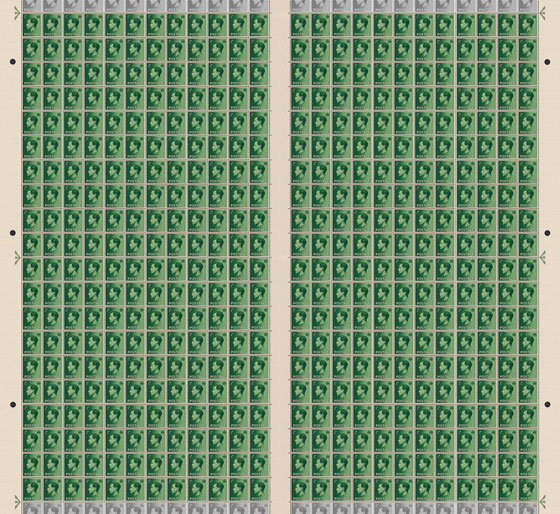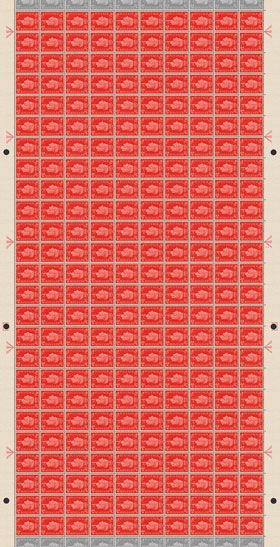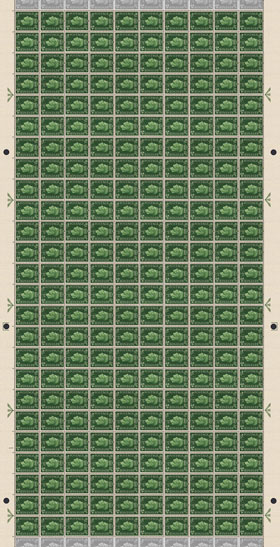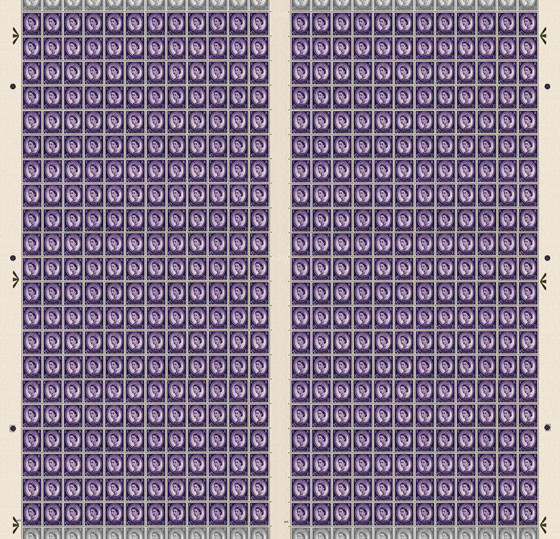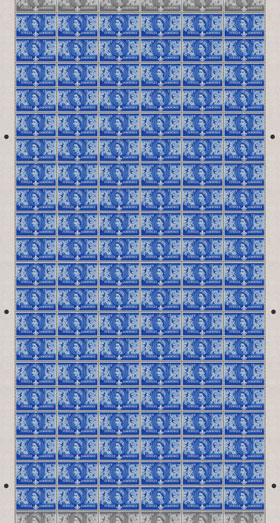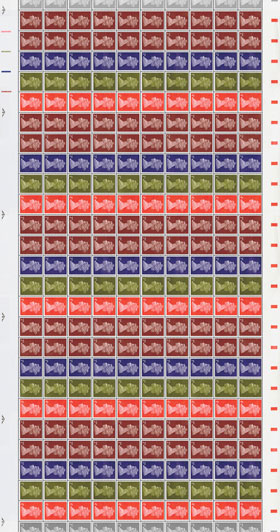
Single Row Perforation Comb
Trials for continuous printing of rolls in letterpress began in 1913 at Somerset House. A 200-set plate (20×10) was requested from the Royal Mint (six working plates were made but only one was delivered, plate number 2/338) and a special press was ordered from Grover & Co. Trials continued into 1915 but then stopped because of the war and lack of success.
Trials restarted in 1920 but this time plate 2/338 was reconfigured as two panes of 90. The results of the trials were good enough that in 1921 rolls were tested in various affixing machines. Testing went well and in November 1921 the 530 (E) rolls on hand were issued. Then in March 1922 a warrant was issued for 10,000 (E) rolls for issue, followed by a warrant in May 1923 for 12,000 (E) rolls. The six working plates were transferred to Waterlow in 1924.
A block of 27 came to market in 2001 printed on esparto paper (a high quality paper made from esparto grass fibre). This was likely the top three rows of the right pane of a trial from this period. The block has since been split.
200-set plate reconfigured as 180-set (centre columns removed).
Click the image to enlarge.
King George V
Profile Head
The printing contract passed from Harrison to Waterlow in 1924. Waterlow was to print rolls by the continuous letterpress process established at Somerset House using modified printing presses built by Grover (the same company as the perforators). Plates were allocated current numbers (sequence numbers) by the Royal Mint. The first plate for ½d continuous rolls was number 897. A repetition number specified a sequence within duty value, thus the ½d plate numbering begins: 1/897, 2/898, 3/909. The current and repetition numbers were sometimes swapped, for example 897/1.
Continuous rolls had to be perforated in the web and this was done initially with single-row combs (Type R1 sideways, Type R2 endways). In early 1928 a double-row comb was made for sideways rolls (Type R3), then later the same year a double-row comb was made for endways rolls (Type R4).

There were concerns expressed in November 1923 about the unprinted central gutter and it was decided to “cross perforate” the gutter with a pattern of holes to avoid any misuse. Designs were made for postage, insurance, and excise revenue (aka entertainment tax) stamps. The patterns used do not appear in the finished rolls as the central gutters were removed and destroyed, but the patterns can be seen in the Grover perforation Master Plates which still exist: MP91 (endways rolls), MP91A (sideways rolls), MP91B (health and unemployment insurance), and MP91C (excise revenue). Those for double-row combs are MP262 (sideways rolls) and MP268 (endways rolls).
Images are oriented with the delivery edge of the roll at the top, thus the marginal markings (sheet numbers, counting mark and perforation guide punch holes) are in the same position for all sheets. The greyed out rows represent impressions of the plate before and after the impression shown.

192-set plates for sideways delivery. Two panes, each 12 rows of 8, sideways, with a 0.925″ gutter. The central gutter is 0.8″+1/16″+1/16″ wide, cancelled with diagonal cross perforations. Click the image to enlarge.
| ½d | 1/897 | 9.1.24 | 2/898 | 9.1.24 | 3/909 | 26.1.24 |
| 4/926 | 13.8.24 | 5/927 | 14.8.24 | 6/979 | 28.6.26 | |
| 7/1009 | 1.5.31 | 8/1100 | 1.5.31 | |||
| 1d | 1/903 | 14.1.24 | 2/904 | 14.1.24 | 3/916 | 22.2.24 |
| 4/917 | 25.2.24 | |||||
| 1½d | 1/911 | 1.2.24 | 2/912 | 1.2.24 | 3/980 | 28.6.26 |
| 4/1070 | 18.3.30 | 5/1131 | 16.11.32 | |||
| 2d | 1/918 | 19.3.24 | 2/919 | 19.3.24 |

180-set plates for endways delivery. Two panes, each 10 rows of 9, with a 1.6625″ gutter. The central gutter is 0.8″+0.8″+1/16″ wide, cancelled with diagonal cross perforations. Click the image to enlarge.
| ½d | 1/905 | 21.1.24 | 2/906 | 21.1.24 | 3/907 | 24.1.24 |
| 4/908 | 24.1.24 | 5/910 | 25.1.24 | 6/940 | 20.1.25 | |
| 7/941 | 20.1.25 | 8/1068 | 8.1.30 | 9/1133 | 28.11.32 | |
| 1d* | 1/337 | 30.9.13 | 2/338 | 30.9.13 | 3/339 | 1.10.13 |
| 4/340 | 1.10.13 | 5/341 | 2.10.13 | 6/342 | 2.10.13 | |
| 1/1069 | 21.1.30 | 2/1134 | 28.11.32 | |||
| 1½d | 1/913 | 20.2.24 | 2/914 | 20.2.24 | 3/915 | 21.2.24 |
| 4/1132 | 21.11.32 |
* 1913 1d plates transferred from Somerset House to Waterlow in 1924.
P.U.C.
Postal Union Congress sheets were the same layout as Profile Head sheets, and were perforated using the double-row combs introduced in 1928. A new sequence of plate numbers was allocated. Plates for PUC rolls were allocated current numbers 31 to 36, with a single repetition number of each.

192-set plates for sideways delivery. Two panes, each 12 rows of 8, sideways, with a 0.925″ gutter. Click the image to enlarge.
| ½d | 1/31 | 5.3.29 |
| 1d | 1/32 | 19.3.29 |
| 1½d | 1/33 | 20.3.29 |

180-set plates for endways delivery. Two panes, each 10 rows of 9, with a 1.6625″ gutter. This example sheet is for delivery Lower End First, therefore shown upside down. Click the image to enlarge.
| ½d | 1/34 | 5.3.29 |
| 1d | 1/35 | 13.3.29 |
| 1½d | 1/36 | 13.3.29 |
Photogravure
Harrison won the printing contract back starting 1 Jan 1934 with the promise of upgrading the printing process from letterpress to photogravure, a faster and lower cost process. Both printing in the web and perforating in the web would be more efficient.
The circumference of endways cylinders was initially 19.95″, as can be seen by the boxes around the perforation guide punch holes on the 1935 registration sheets (A17, B12, C3), there are three boxes, one every seven rows, and 3×7 gives 21 rows at 0.95″ equals 19.95″. However, the next three registration sheets (1936 C23, and 1937 King Edward VIII A7 and B7) have etched arrows every ten rows, indicating only 20-row cylinders, and 20 times 0.95″ equals 19″. The circumference returned to 19.95″ for King George VI where marginal arrows were applied in black as a separate operation.
A triple-row comb was used for endways rolls and a quintuple-row comb used for sideways rolls. Both combs had two states. The first state with pins across the central gutter, the second state with all but two pins removed leaving a single extension pin on each side of the central gutter. There are thus two pin counts for each comb, for the triple row: 2376 and 2340, for the quintuple row: 3330 and 3260. The following diagrams show the second state of each.

504-set cylinders for endways delivery. Two panes, each 21 rows of 12. The central gutter is one stamp wide. No marginal arrows. Click the image to enlarge.
| ½d | A17 | 26.7.35 |
| 1d | B12 | 1.8.35 |
| 1½d | C3 | 15.1.35 |
480-set cylinders for endways delivery. Two panes, each 20 rows of 12. The central gutter is one stamp wide. There are marginal arrows every ten rows.
| 1½d | C23 | 20.1.36 |
The circumference of sideways cylinders was also 19.95″. This was achieved by reducing the stamp size by two thousandths of an inch, from 0.8″ x 0.95″ to 0.798″ x 0.948″, and 25 times 0.798″ equals 19.95″.

500-set cylinders for sideways delivery. Two panes, each 25 rows of 10, sideways. The central gutter is one stamp high. There are marginal arrows every five rows. Click the image to enlarge.
| ½d | A10 | 26.7.35 |
| 1d | B11 | 19.3.36 |
| 1½d | C21 | 16.3.36 |
| 2d | D3 | 2.4.36 |
King Edward VIII
Only a limited set of ten King Edward VIII rolls were issued due to the brief reign and, of those, only the ½d and 1d for endways delivery were continuously printed. The cylinders had marginal arrows every ten rows, hence 20-row rather than 21-row, similar to the later photogravure endways cylinders. Sheets were perforated with the triple-row comb introduced for photogravure in its second state with 2340 pins.

480-set cylinders for endways delivery. Two panes, each 20 rows of 12. The central gutter is one stamp wide. There are marginal arrows every ten rows. Click the image to enlarge.
| ½d | A7 | 12.3.37 |
| 1d | B7 | 21.4.37 |
King George VI
King George VI endways rolls were printed with 21-row cylinders. The difficulty printing marginal arrows every ten rows was solved by printing them in black as a separate operation. Both single and double pane endways cylinders were used.
All sideways cylinders for this reign were single pane with etched arrows every five rows. The extension perforations, which are known from panes of these sheets used in the 1940 6d booklets, suggest that 1d sheets were perforated on the left of the machine, and ½d sheets on the right.
Click the images to enlarge.
| Dark Colours | Pale Colours | New Colours | ||||
|---|---|---|---|---|---|---|
| ½d | A13 | 6.5.38 | ||||
| 1d | B16 | 8.2.38 | B66 | 28.9.42 | B76 | 2.4.51 |
| 1½d | C8 | 4.2.38 | C28 | 21.9.51 | ||
| 2d | D4 | 2.2.38 | D13 | 19.5.42 | D16 | 16.2.51 |
| 2½d | L3 | 26.6.40 | L17 | 20.8.42 | L21 | 2.4.51 |
| Dark Colours | Pale Colours | New Colours | ||||
|---|---|---|---|---|---|---|
| ½d | A88 | 26.3.42 | ||||
| 1d | B61 | 20.2.42 | ||||
| 1½d | C13 | 22.3.38 | ||||
| 2d | ||||||
| 2½d | L1 | 7.6.40 | L11 | 6.5.42 | ||
| Dark Colours | Pale Colours | New Colours | ||||
|---|---|---|---|---|---|---|
| ½d | A2 | 20.10.37 | A110 | 2.2.51 | ||
| 1d | B- | 22.9.37 | B92 | 8.3.51 | ||
| 1½d | C- | 7.9.51 | ||||
| 2d | D14 | 20.9.48 | D14 | 2.4.51 | ||
| 2½d | L20 | 23.2.51 | ||||
Queen Elizabeth II
Wilding
Wilding cylinders followed the format of the previous reign: 21-row endways cylinders with marginal arrows every ten rows, applied in black as a separate operation. Both single and double pane endways cylinders were used. All sideways Wilding cylinders were single pane with etched arrows every five rows.
504-set cylinders for endways delivery. Two panes, each 21 rows of 12. The central gutter is one stamp wide. There are black marginal arrows every ten rows. Click the image to enlarge.
| 1½d | C3 | 19.2.54 | C4* | 27.11.54 | ||
| 2d | D3 | 19.2.54 | D4 | 5.3.54 | ||
| 2½d | L3 | 24.12.53 | L4* | 19.2.54 | L5 | 8.12.64 |
| 3d | M3* | 26.8.57 | M4* | 20.9.57 | M5 | 30.9.57 |
| M6* | 2.12.57 | M7* | 25.2.59 | M8* | 4.3.59 | |
| M9 | 16.4.59 | M10 | 20.11.59 | M11* | 18.8.60 | |
| M12* | 22.12.60 | M13 | 17.2.61 | M14 | 24.5.63 | |
| 4d | P1 | 23.3.65 |
* destroyed at an early stage with few impressions.
| ½d | 4† | 23.10.57 | ||||
| 1d | 7† | 23.10.57 | B4 | 7.11.57 | ||
| 6d | Q1 | 20.4.66 |
† converted from counter sheet cylinders by adding a 21st row.
| ½d | A1 | 27.11.53 | A2 | 11.12.53 | A3 | 23.5.56 |
| 1d | B1 | 11.12.53 | B2 | 11.12.53 | B3 | 23.5.56 |
| 1½d | C1 | 22.1.54 | C2* | 8.2.54 | ||
| 2d | D1 | 11.12.53 | D2* | 24.12.53 | ||
| 2½d | L1 | 24.12.53 | L2* | 24.12.53 | ||
| 3d | M1* | 22.8.57 | M2 | 22.8.57 | ||
| 4d | P2 | 9.4.65 |
* destroyed at an early stage with few impressions.
SG lists ½d cylinder A4, but Post Office records have no such cylinder.
Boy Scout Jamboree
126-set cylinders for endways delivery. Single pane, 21 rows of 6. Click the image to enlarge.
| 2½d | J1 | 13.5.57 | ||||
| 4d | J1 | 2.5.57 | ||||
| 1/3 | J1* | 3.5.57 | J2 | 8.5.57 |
* destroyed at an early stage with few impressions.
Machin
Machin cylinders followed the same format as Wilding cylinders, with the exception that sideways rolls marginal arrows were every ten rows, applied in black as a separate operation (five rows for the multi-value roll). Early cylinders M1-M2 and P1-P4 were Head A, all others were Head B.
| 2d | D1 | 4.1.68 | ||||
| 3d | M2 | 5.7.67 | ||||
| 4d | P1 | 5.7.67 | P5 | 20.2.68 | ||
| 5d | S2 | 9.7.68 |
Deegam lists a 4d (H) roll from cylinder P7, but Post Office records have no such cylinder. More recent work indicates that cylinder P1 was Head A, P5 was Head B, and P7 did not exist.
| 2d | D2 | 5.8.68 | ||||
| 6d | Q2 | 25.1.68 |
| 1d | B1 | 5.1.68 | B2 | 9.2.68 | ||
| 3d | M1 | 14.6.67 | M4 | 7.1.69 | ||
| 4d | P2* | 27.7.67 | P3 | 4.8.67 | P4* | 23.1.68 |
| 5d | S1* | 27.6.68 | S3 | 5.8.68 | S4 | 13.8.68 |
* destroyed at an early stage with few impressions.
50/100-set cylinders for “G” multi-value rolls. Single pane, 25 rows of 10, sideways. Rotary perforated using the APS “Swedish Lawnmower”. Click the image to enlarge.
| 1d | B3* | 25.10.68 | B4* | 2.12.68 | B5 | 5.12.68 |
| 2d | D3 | 25.10.68 | ||||
| 3d | M3 | Oct 68 | ||||
| 4d | P6 | Oct 68 |
* destroyed at an early stage with few impressions.
| Cyl | Set | Impressions | Type | Head | Rolls | SG Spec | |
|---|---|---|---|---|---|---|---|
| 1d | B1 | 504 | 1,405,528 | B | E,X,Z | U2 | |
| B2 | 504 | 962,950 | B | E,X,Z | U2 | ||
| B3* | 50 | 3,188 | MV | B | GS,GL | U4 | |
| B4* | 50 | 1,720 | MV | B | GS,GL | U4 | |
| B5 | 50 | 936,964 | MV | B | GS,GL | U4 | |
| 2d | D1 | 250 | 544,082 | S | B | T | U6 |
| D2 | 252 | 58,462 | B | V | U6 | ||
| D3 | 100 | 885,906 | MV | B | GS,GL | U7 | |
| 3d | M1 | 504 | 614,970 | A | U,AC,AD | U8,10 | |
| M2 | 250 | 220,057 | S | A | S | U8,9 | |
| M3 | 50 | 886,745 | MV | B | GS,GL | U8 | |
| M4 | 504 | 171,414 | B | AD | U10 | ||
| 4d | P1 | 250 | 526,897 | S | A | H | U11,13,14 |
| P2* | 504 | 1,730 | A | A | U11 | ||
| P3 | 504 | 105,506 | A | A | U11,13,14 | ||
| P4* | 504 | 1,831 | A | A | U11 | ||
| P5 | 250 | 198,639 | S | B | H | U14 | |
| P6 | 50 | 886,163 | MV | B | GS,GL | U15 | |
| 5d | S1* | 504 | 598 | B | AE | U17 | |
| S2 | 250 | 232,006 | S | B | AF | U17 | |
| S3 | 504 | 30,003 | B | AE | U17 | ||
| S4 | 504 | 13,650 | B | AE | U17 | ||
| 6d | Q2 | 252 | 46,373 | B | J | U18 |
* destroyed at an early stage with few impressions.
